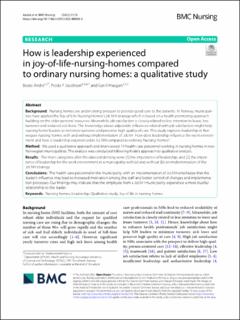How is leadership experienced in joy-of-life-nursing-homes compared to ordinary nursing homes: a qualitative study
Peer reviewed, Journal article
Published version
Permanent lenke
https://hdl.handle.net/11250/3045422Utgivelsesdato
2022Metadata
Vis full innførselSamlinger
- Artikler / Articles [1172]
- Publikasjoner fra CRIStin [1110]
Sammendrag
Background: Nursing homes are under strong pressure to provide good care to the patients. In Norway, municipalities have applied the ‘Joy-of-Life-Nursing-Homes’ (JoLNH) strategy which is based on a health-promoting approach building on the older persons’ resources. Meanwhile job satisfaction is closely related to less intention to leave, less turnover and reduced sick leave. The knowledge about adjustable infuences related with job satisfaction might help nursing home leaders to minimize turnover and preserve high quality of care. This study explores leadership in Norwegian nursing homes with and without implementation of JoLNH: How does leadership infuence the work environment and how is leadership experienced in JoLNH compared to ordinary Nursing Homes?
Method: We used a qualitative approach and interviewed 19 health care personnel working in nursing homes in two Norwegian municipalities. The analysis was conducted following Kvale’s approach to qualitative analysis.
Results: The main categories after the data condensing were [1] the importance of leadership, and [2] the importance of leadership for the work environment in a municipality with (a) and without (b) an implementation of the JoLNH strategy.
Conclusions: The health care personnel in the municipality with an implementation of JoLNH emphasize that the leader’s infuence may lead to increased motivation among the staf and better control of changes and implementation processes. Our fndings may indicate that the employee from a JoLNH municipality experience a more trustful relationship to the leader.
Beskrivelse
This article is licensed under a Creative Commons Attribution 4.0 International License, which permits use, sharing, adaptation, distribution and reproduction in any medium or format, as long as you give appropriate credit to the original author(s) and the source, provide a link to the Creative Commons licence, and indicate if changes were made. The images or other third party material in this article are included in the article’s Creative Commons licence, unless indicated otherwise in a credit line to the material. If material is not included in the article’s Creative Commons licence and your intended use is not permitted by statutory regulation or exceeds the permitted use, you will need to obtain permission directly from the copyright holder. To view a copy of this licence, visit http://creativecommons.org/licenses/by/4.0/. The Creative Commons Public Domain Dedication waiver (http://creativeco mmons.org/publicdomain/zero/1.0/) applies to the data made available in this article, unless otherwise stated in a credit line to the data.

